Allure定制报告
1、定制报告常用的装饰器
结合表和示例图查看
| 使用方法 | 参数值 | 参数说明 |
|---|---|---|
| @allure.epic() | 项目名称 | 项目名称,树结构第一层 |
| @allure.feature() | 模块名称 | 模块名称,树结构第二层 |
| @allure.story() | 用户故事 | 测试用例分组名,树结构第三层 |
| @allure.title() | 用例标题 | 测试用例标题,树结构第四层 |
| @allure.severity() | 用例等级/优先级 | blocker,critical,normal,minor,trival |
| @allure.description() | 用例描述 | 用例描述 |
| @allure.link() | 自定义链接 | |
| @allure.issure() | bug链接地址 | |
| @allure.testcase() | 测试用例地址 | |
| @allure.step() | 测试步骤 | |
| @allure.attachment() | 附件 |
示例图
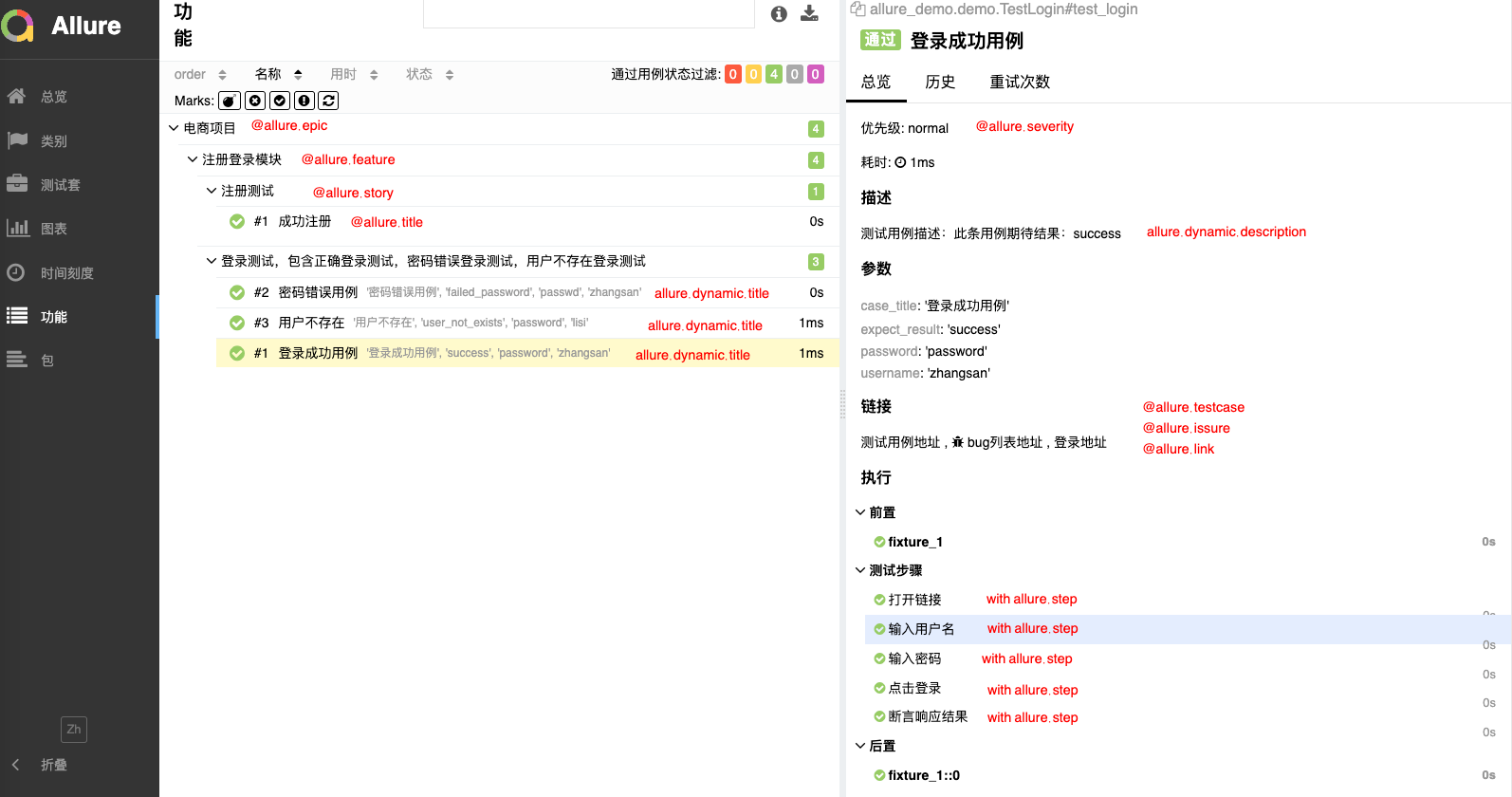
2、allure.dynamic在测试方法中动态添加定制
在对测试方法进行参数化的时候,使用@allure.title装饰器只能对所有测试用例定制一样的标题,想要动态定制用例标题可以在测试方法中使用allure.dynamic.title()来进行定制。
定制代码示例
login_data = [
("登录成功用例", "zhangsan", "password", "success"),
("密码错误用例", "zhangsan", "passwd", "failed_password"),
("用户不存在", "lisi", "password", "user_not_exists")
]
@pytest.mark.parametrize("case_title,username,password,expect_result", login_data)
def test_login(case_title, username, password, expect_result):
print("登录测试")
allure.dynamic.title(case_title)
allure.dynamic.description(f"测试用例描述:此条用例期待结果:{expect_result}")
定制效果

实际上表中除了epic所有定制都可以在测试方法中动态定制,具体如下图
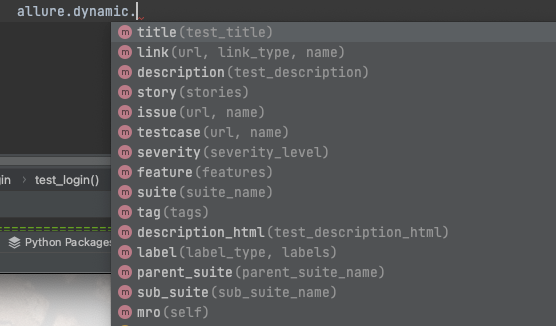
3、用例等级的定制
- blocker:阻塞缺陷,致命bug
- critical:严重缺陷,功能未实现或错误
- normal:一般缺陷(80%都是此类缺陷),默认等级
- minor:次要缺陷,界面显示问题
- trivial:轻微缺陷,提示问题
使用方法:@allure.severity(allure.severity_level.BLOCKER)
注意:
该装饰器既可以修饰方法也可以修饰类
不修饰的情况下,默认等级为normal
4、用例描述的定制
- 使用装饰器
@allure.description() - 动态定制
allure.dynamic.description()
@allure.title("注销用例标题1")
@allure.description("测试注销1")
def test_logout(self):
print("注销")
allure.dynamic.title("注销用例标题2")
allure.dynamic.description("测试注销2")
注意:
使用动态定制会覆盖使用装饰器定制
5、链接的定制
- 测试用例链接:
@allure.testcase(url=链接地址,name=名称) bug链接:@allure.issue(url=链接地址,name=名称)- 自定义链接:
@allure.link(url=链接地址,name=名称)
@allure.link(url="https://passport.jd.com/new/login.aspx", name="登录地址")
@allure.issue(url="https://www.google.com", name="bug列表地址1")
@allure.testcase(url="https://testlink.org/", name="测试用例地址1")
@pytest.mark.parametrize("case_title,username,password,expect_result", login_data)
def test_login(self, case_title, username, password, expect_result):
print("登录测试")
allure.dynamic.link(url="https://www.baidu.com",name="登录链接")
allure.dynamic.issue(url="https://www.baidu.com", name="bug列表地址2")
allure.dynamic.testcase(url="https://www.baidu.com", name="测试用例地址2")
注意:
链接同样支持动态定制
动态定制不会覆盖装饰器定制,会把所有链接都显示出来
6、步骤的定制
- 使用装饰器
@allure.step() - 在测试方法内使用
with allure.step():
示例:
@allure.epic("电商项目")
@allure.feature("购物车模块")
class TestCart:
@allure.step("第一步,测试加入购物车")
@allure.story("测试添加购物车方法")
@allure.title("加入购物车测试用例")
def test_add_cart(self):
# 第一步,登录
with allure.step("第一步,登录"):
print("登录成功")
# 第二步,搜索商品
with allure.step("第二步,搜索商品"):
print("搜索成功")
# 第三步,将商品加入购物车
with allure.step("第三步,加入购物车"):
print("加入购物车成功")
# 第四步,打开购物车
with allure.step("第四步,打开购物车"):
print("打开购物车成功")
# 第五步,断言验证是否添加成功
with allure.step("第五步,断言验证是否加入成功"):
print("验证加入购物车通过")
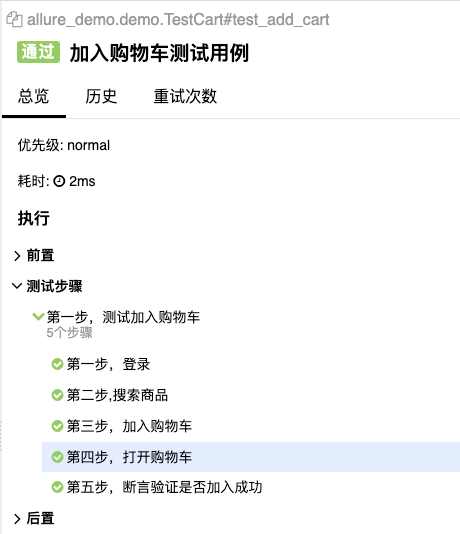
7、附件的定制
使用allure.attachment对附件进行定制
参数:
body:附件内容name:附件名称attachment_type:附件类型,支持的类型如下
-
UI自动化项目
def test_register(self): print("注册测试") with open("./allure_demo/screen_shot/fail_snap.jpg","rb") as f: allure.attach(body=f.read(), name="注册测试失败截图", attachment_type=allure.attachment_type.JPG)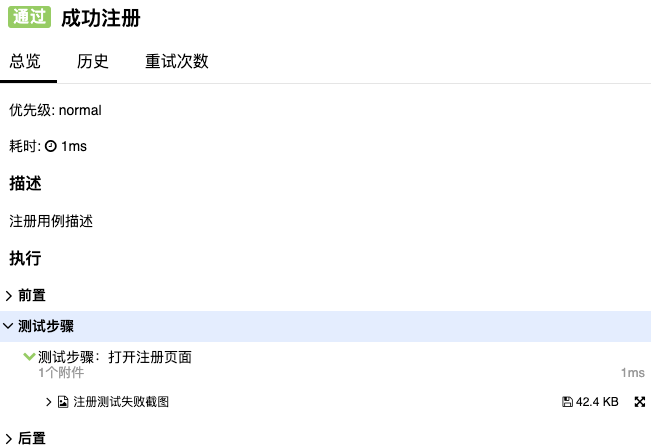
-
接口自动化项目
def test_search_api(): allure.attach(body=url, name="请求地址", attachment_type=allure.attachment_type.TEXT) allure.attach(body=json.dumps(params), name="请求参数", attachment_type=allure.attachment_type.TEXT) resp = requests.get(url, params=params) allure.attach(body=resp.text, name="响应数据", attachment_type=allure.attachment_type.TEXT)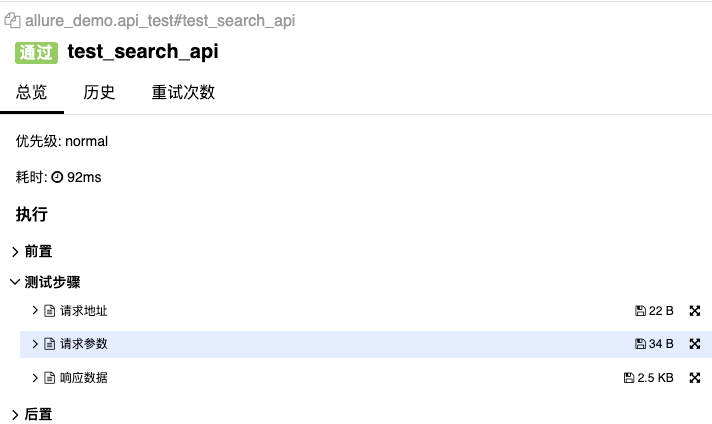

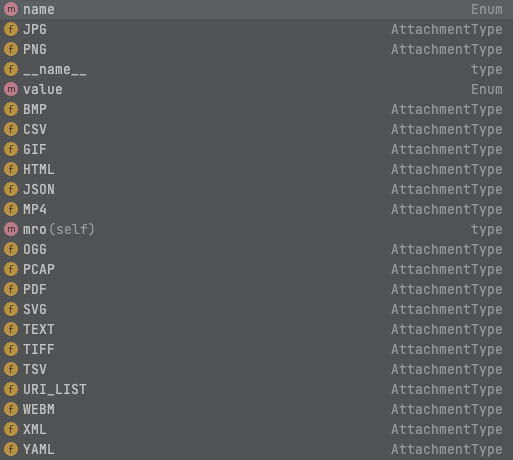


【推荐】国内首个AI IDE,深度理解中文开发场景,立即下载体验Trae
【推荐】编程新体验,更懂你的AI,立即体验豆包MarsCode编程助手
【推荐】抖音旗下AI助手豆包,你的智能百科全书,全免费不限次数
【推荐】轻量又高性能的 SSH 工具 IShell:AI 加持,快人一步
· 25岁的心里话
· 闲置电脑爆改个人服务器(超详细) #公网映射 #Vmware虚拟网络编辑器
· 基于 Docker 搭建 FRP 内网穿透开源项目(很简单哒)
· 零经验选手,Compose 一天开发一款小游戏!
· 一起来玩mcp_server_sqlite,让AI帮你做增删改查!!